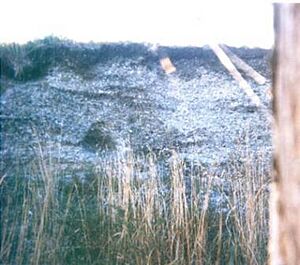History of Chiloé facts for kids
The history of Chiloé is about a group of islands in southern Chile. Its story is special because it has often been cut off from the rest of the world. A historian named Renato Cárdenas once said that Chiloé is like its own unique place. He described it as being more connected to the sea than to the land. It was a strong community with a deep love for its home.
Contents
Who Lived in Chiloé First?
Chiloé's history began over 7,000 years ago. This is when the first people arrived there. Along the coast of Chiloé Island, you can find many old trash piles called middens. These middens contain shells from sea creatures, stone tools, and old bonfire remains. Sometimes, bones of sea birds and even human skeletons have been found.
These findings show that early groups of people moved around a lot. They gathered food from the sea, like clams and mussels. They also hunted and fished. Tools found at these sites include chopping tools, stone flakes, and hand axes. Some tools were also made from bone. The oldest middens are about 7,900 years old. Some local communities still use these spots as modern trash dumps today.

When Spanish explorers arrived in the 1500s, three main groups lived on Chiloé Island. These were the Chono, Huilliche, and Cunco peoples. These native groups were very skilled at sailing their boats called dalcas. They navigated the tricky waters of the Chiloé Archipelago so well that the Spaniards were very impressed. Their daily food included cooked vegetables like potatoes and corn. They also ate many kinds of fish and seafood.
Spanish Arrival and Settlement
The first Spaniard to see Chiloé's coast was Alonso de Camargo in 1540. He was on his way to Peru. Later, in 1553, Captain Francisco de Ulloa explored the islands. He reached the Chacao Channel during an expedition ordered by Pedro de Valdivia. Because of this, he is seen as the first European to discover Chiloé. In 1558, a Spanish soldier named García Hurtado de Mendoza led a trip that claimed Chiloé for Spain.
The city of Castro was founded in 1567. The Spanish explorers first called the island New Galicia. But this name did not last. The island became known as Chiloé, which means “place of seagulls” in the Huilliche language.
In 1600, a Dutch pirate named Baltazar de Cordes took over Castro. But the Spanish quickly took the city back. In 1643, a Dutch expedition to Valdivia, led by Hendrik Brouwer, attacked and took control of Chiloé for a short time.
Jesuit missionaries arrived in Chiloé around 1600. Their job was to teach the local people about Christianity. They built many small churches across the islands. By 1767, there were 79 churches. Today, more than 150 wooden churches built in the traditional style can be found there. Many of these are now World Heritage Sites, recognized by UNESCO. After the Jesuits left in 1767, the Franciscans took over the religious mission from 1771.
Becoming Part of Chile
Chiloé was directly connected to the Viceroyalty of Peru. This meant that the fight for independence in Chile did not affect Chiloé much at first. In fact, Chiloé was one of the last places in South America to remain under Spanish rule. It only became part of the Chilean republic in 1826. This was eight years after Chile declared its independence. It happened after two failed attempts to gain independence in 1820 and 1824.
From 1843, many Chilotes (people from Chiloé) moved to Patagonia to find work. They mostly went to Punta Arenas. But as life and work improved in Chiloé in the next century, fewer people left.
In the 1800s, Chiloé was a busy place for foreign whalers, especially from France. From the mid-1800s to the early 1900s, Chiloé was the main producer of railroad ties for the entire continent. New towns grew because of this industry. These included Quellón, Dalcahue, Chonchi, and Quemchi. From 1895, land was given to European settlers and large factories.
As farming grew, people started living in the inland areas of Chiloé Island. Before this, most people lived only along the coast. By 1912, the inland areas were fully settled. This happened with the building of a railroad between Ancud and Castro. This railroad is no longer used today.
Chiloé's Recent Times
In the last few decades of the 1900s, Chiloé changed a lot. Its ocean resources were opened up to big fishing and fish farming companies. The economy changed from one based on traditional fishing and farming to one where people worked for wages. New businesses, like salmon farming, brought new jobs to Chilotes. But these jobs often paid low wages.
This shift to wage labor pulled islanders away from their old ways of life. It also changed their group work practices, like the minga. The minga was a special tradition where people helped each other build houses or move them. It had been a big part of the islanders' identity for many years.
A plan to build a bridge from Chiloé Island to mainland Chile was first suggested in 1972. It was officially started by President Ricardo Lagos (2000–2006). He launched the project as part of celebrations for the Bicentennial of Chile. However, in 2006, the Chacao Channel bridge project was stopped. This happened because of worries about its high cost.
In May 2012, President Sebastián Piñera brought the bridge project back. He announced that companies from around the world could bid to build the bridge. There was a limit of US$740 million for the investment.
In late 2012, LAN Airlines became the first airline to offer flights to Chiloé Island. They started regular flights between Puerto Montt and the airport of Mocopulli, Dalcahue. Before this, the only way to get to Chiloé Island was by taking a ferry across the Chacao Channel.
See also
 In Spanish: Historia de Chiloé para niños
In Spanish: Historia de Chiloé para niños


